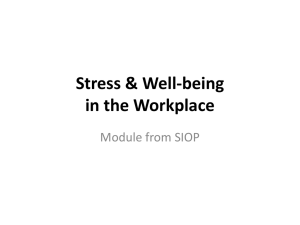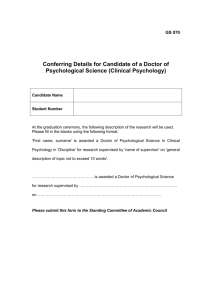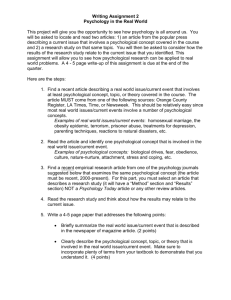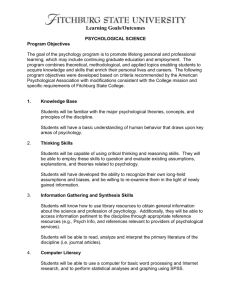Research Paper Guidelines – Abnormal Psychology
advertisement
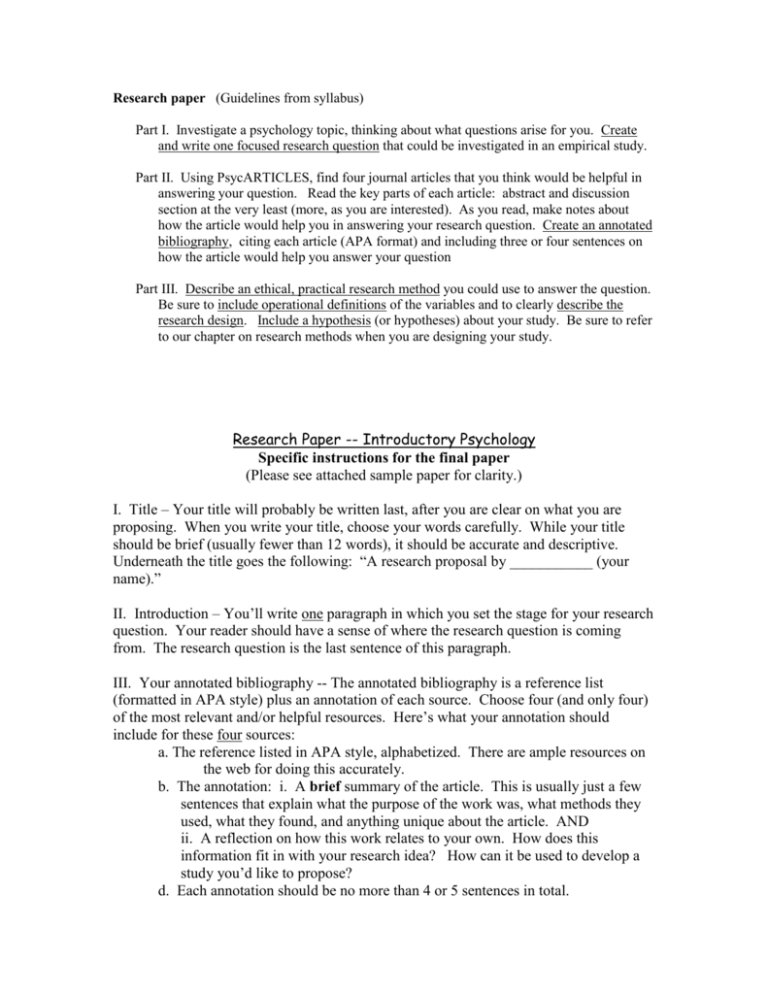
Research paper (Guidelines from syllabus) Part I. Investigate a psychology topic, thinking about what questions arise for you. Create and write one focused research question that could be investigated in an empirical study. Part II. Using PsycARTICLES, find four journal articles that you think would be helpful in answering your question. Read the key parts of each article: abstract and discussion section at the very least (more, as you are interested). As you read, make notes about how the article would help you in answering your research question. Create an annotated bibliography, citing each article (APA format) and including three or four sentences on how the article would help you answer your question Part III. Describe an ethical, practical research method you could use to answer the question. Be sure to include operational definitions of the variables and to clearly describe the research design. Include a hypothesis (or hypotheses) about your study. Be sure to refer to our chapter on research methods when you are designing your study. Research Paper -- Introductory Psychology Specific instructions for the final paper (Please see attached sample paper for clarity.) I. Title – Your title will probably be written last, after you are clear on what you are proposing. When you write your title, choose your words carefully. While your title should be brief (usually fewer than 12 words), it should be accurate and descriptive. Underneath the title goes the following: “A research proposal by ___________ (your name).” II. Introduction – You’ll write one paragraph in which you set the stage for your research question. Your reader should have a sense of where the research question is coming from. The research question is the last sentence of this paragraph. III. Your annotated bibliography -- The annotated bibliography is a reference list (formatted in APA style) plus an annotation of each source. Choose four (and only four) of the most relevant and/or helpful resources. Here’s what your annotation should include for these four sources: a. The reference listed in APA style, alphabetized. There are ample resources on the web for doing this accurately. b. The annotation: i. A brief summary of the article. This is usually just a few sentences that explain what the purpose of the work was, what methods they used, what they found, and anything unique about the article. AND ii. A reflection on how this work relates to your own. How does this information fit in with your research idea? How can it be used to develop a study you’d like to propose? d. Each annotation should be no more than 4 or 5 sentences in total. IV. Research Proposal 1. Restate your research question exactly. 2. Hypothesis (a statement about what you expect to find) 3. Method of study a. Participants (who, how many, how recruited) b. Procedure (what will happen, step-by-step). This depends completely on whether you are doing a descriptive, correlational, or experimental study. Please review the Ch. 2 from our first reading of the semester. If you are using questionnaires, please be sure to name them correctly and give the reference for them. 4. References (included if you cite anything in your research proposal). APA format, of course. (See next pages for sample paper.) The psychological effects of aerobic exercise on older, sedentary adults A research proposal by Robert A. Swoap Accumulating evidence supports the popular belief that physical activity is associated with psychological health. In older adults, however, there has been mixed evidence as to whether participation in regular exercise leads to improved psychological health and psychological well-being. Further, many of the existent studies with older adults have focused on the relief of negative emotions in a clinical population (e.g., older adults with diagnosed depression). It is important to understand the impact of regular, aerobic exercise in non-clinical populations of sedentary older adults. In this paper, I will propose a study that will attempt to answer the following question. How will a 12-week program of aerobic exercise affect the psychological well-being of older adults who have not exercised regularly in the last year? Annotated Bibliography (Four relevant sources) Arent, S. M., Landers, D. M., & Etnier, J. L. (2000). The effects of exercise on mood in older adults: A meta-analytic review. Journal of Aging and Physical Activity, 8, 407–430. These researchers reviewed 32 studies examining the extent to which exercise affects mood in older adults. It was concluded that chronic exercise is associated with improved mood in the elderly. Moderating variables and implications for exercise prescription to improve mood in the elderly are discussed in the article. This paper is immensely helpful for my proposal because the authors make specific recommendations as to future directions for this line of research. It helps me with methodological design and provides a background of knowledge that will help me put my project in perspective. Hansen, C. J., Stevens, L. C. & Coast, J. R. (2001). Exercise duration and mood state: How much is enough to feel better? Health Psychology, 20, 267-275. Cheryl Hansen and her colleagues studied college students to determine the length of time in one session of physical activity that would be sufficient to show a positive mood improvement. They attempted to establish a minimal duration of exercise from which positive psychological benefits may accrue. In general, the results suggest that in this population, exercising for ten minutes at an aerobic level of 60% is sufficient for increasing vigor, decreasing fatigue, and decreasing total negative mood state. This study is relevant to my project since I will be using different lengths of exercise time in my experimental groups. It was, however, conducted on a much younger population; my study will attempt to replicate their findings in an older population. It was also focused on just one bout of exercise, where I will be looking at a three month program. King, A. C., Taylor, C. B., & Haskell, W. L. (1993). Effects of differing intensities and formats of 12 months of exercise training on psychological outcomes in older adults. Health Psychology, 12, 292–300. King and her colleagues randomly assigned older adults (n = 357) to exercise groups or an assessment-only control group. After a year of training, exercisers showed reductions in perceived stress and anxiety in relation to controls. This study was well-designed and is particularly relevant to my own study. However, where the researchers used adults ages 50-65, I plan to study adults 65-75 years of age during a shorter time frame of exercise. Further, I won’t use their measures which focused on perceived stress and anxiety. Madden, D., Blumenthal, J,, Allen, P., & Emery, C. (1989). Improving aerobic capacity in healthy older adults does not necessarily lead to improved cognitive performance. Psychology and Aging, 4, 307-320. These researchers randomly assigned older adults to either an aerobic exercise group, a non-aerobic exercise (yoga) group, or a wait-list control group. The older adults demonstrated a significant increase in aerobic capacity but did not show improvement on tests of attention and memory retrieval as a function of aerobic exercise training. This study examined cognitive performance where I want to investigate mood. Still, the article is helpful in that the researchers used a randomized, experimental trial in the target population. For the proposed study, I will modify their design to examine psychological well-being instead of cognitive ability. Research Proposal I. Research question. How will a 12-week program of aerobic exercise affect the psychological well-being of older adults who have not exercised regularly in the last year? II. Hypotheses. Twelve weeks of aerobic exercise will improve the psychological wellbeing (assessed by several measures) of older adults. Further, those adults who are randomly assigned to the 50-minute group will achieve the greatest benefits, as compared to those in the 30-minute or 10-minute group. The 30-minute and 10-minute groups will show moderate benefits as compared to the control group, which is expected to show no improvements. III. Method A. Participants One hundred, twenty sedentary adults from the Asheville area will be recruited for a study examining the effects of exercise on well-being. In order to prevent demand characteristics, participants will not be told that the focus is psychological well-being. Participants ages 65-75 will be solicited through posted information sheets and advertisements in the local newspaper. The participants will be sedentary – engaged in no regular exercise program in the past year – and be willing to be randomized into study groups (including a no-exercise, wait-list control group). Although they will be sedentary, they will undergo a physical assessment to determine their ability to exercise safely. Any participants with significant disease (e.g., heart disease) will be excluded from the current study. B. Procedure 1. Informed consent will be obtained from all participants before the study begins. 2. Random assignment. Each of the participants will be randomly assigned to one of four groups: High, Moderate, Low, and No exercise (described next). 3. Exercise groups. Each of the three exercise groups will be trained in how to exercise at a specific training intensity which will be in the aerobic range (65-80% of maximal heart rate). These groups will meet together three times per week for 12 weeks at a gym and be supervised by trained research assistants throughout their sessions. Each exercise session will begin with a brief warm-up period and then move into aerobic conditioning. The three groups only will differ in number of minutes that they exercise during their sessions. High exercise (60 minutes); Moderate exercise (35 minutes); and Low exercise (15 minutes). The control group will not engage in any regular exercise during the 12week period. 4. Measures. a. The Mental Health Inventory (Veit & Ware, 1983), assesses psychological well-being (focusing on positive affect and emotional ties). A sample question from this inventory is “How much of the time during the past month have you felt calm and peaceful?” and “How much of the time during the past month have you felt happy?” These items are rated on a 6-point scale from “none of the time” to “all of the time.” Scores will be compared between baseline and at the end of the 12 weeks, across the four groups. Embedded within the questionnaire will be distractor items (which assess physical fitness, cognitive skills, and history of illness). These are included to decrease the chance that the participants will simply report gains in their psychological well-being (as a placebo effect). b. Functional Magnetic Resonance Imaging (fMRI). In order to attempt to objectively document increases in well-being, a subset of participants (five from each group, randomly selected) will undergo neuroimaging to assess neural activity in the left prefrontal cortex which has been shown to be associated with levels of happiness (Davidson et al., 2003). Pre- and post-imaging will be compared in this subset of participants. 5. Concluding the study. At the end of the twelve weeks, all participants will be debriefed as to the nature of the research (the question, the hypotheses) and will be given the results as soon as they are available. Further, the control group will be offered a free 12-week exercise program at the same gym. References Davidson R.J., Kabat-Zinn J., Schumacher J., Rosenkranz, M., Muller D, Santorelli S.F., . . . Sheridan, J.F. (2003). Alterations in brain and immune function produced by mindfulness meditation. Psychosomatic Medicine, 65, 564-570. Veit, C. T., & Ware, J. E. (1983). The structure of psychological distress and well-being in general populations. Journal of Consulting and Clinical Psychology, 51, 73042.
